London:
Gallery 1
London, we
know, is a massive resource for public
lettering from times past. We include here one of several galleries of
lettering images to give a hint of these riches. If you have any
information about any of the signs, do email
us.
26 Earlham Street
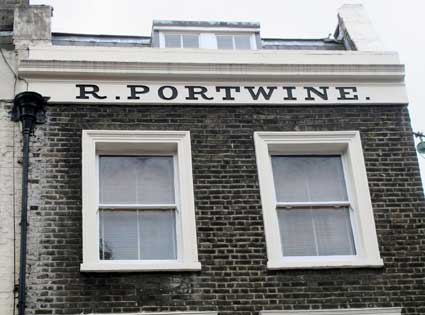 All
photographs courtesy David Gaylard
All
photographs courtesy David Gaylard
'R.PORTWINE.'
with its
careful full stop is painted high above the
Covent Garden Bead Shop, 26 Earlham Street (on the corner with Tower
Court). For information about this very Dickensian of
business names, see the Update below.
14 Earlham Street
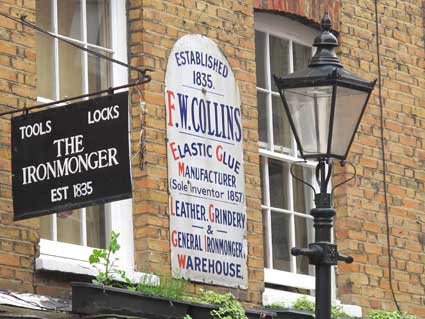
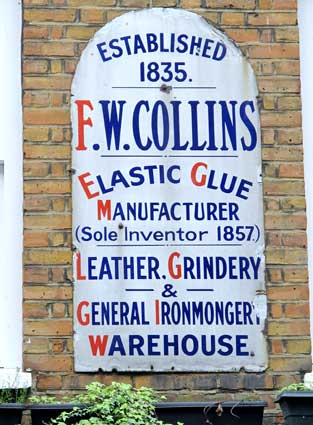 All images
2012
All images
2012
'ESTABLISHED
1835
F.W.COLLINS
ELASTIC GLUE
MANUFACTURER
(Sole
Inventor 1857.)
LEATHER, GRINDERY
-&-
GENERAL IRONMONGERY
WAREHOUSE.'
This fine
enamelled sign is at 14 Earlham Street and
the ironmonger's business ran from this address until 2008. It became a
clothes shop and the sign was left in place.
[UPDATE 17.9.2014: Susan
H writes:
“Saw your photograph of Portwine sign in Earlham Street. This was an
amazing family butchers. I lived down the road at 12a Upper St Martin's
Lane above my father's saddlery business George Parker & Sons (now
gone sadly as Westminster allowed the Georgian Terrace to be knocked
down for a shopping centre).
I was born in 1956 and my parents were using Portwine for at least 18
years of my life, it was an excellent quality butcher…
This ['F.W. Collins', above] was an ironmongery, run by Fred Collins.
It was a wonderfully
eclectic shop but you could get everything to repair your house in
there. Fred was a really nice chap, and his son carried on the business
when it moved nearby.
You also showed saddlery signwriting on a building in Monmouth Street.
As I recall several buildings still had this sort of
signwriting showing around Upper St Martins Lane on the way up to the
Seven Dials.
I lived in WC2 from 1956 to 1977. Where Stringfellows was in
Upper St Martin's Lane was originally a car repair shop run by Bob the
mechanic! The little St Martin's Hotel which I think has now gone
was run by Stratford Johns (actor) for actors/actresses most of whom
seemed to live there rather than just taking a room for a few nights!...
Secondhand saddlery is well worth selling. My father's business
had two Irish gentleman who sat by gas flames, a kettle of cow gum
gently boiling, they cut the leather, fashioned it, sewed it and made
the whole saddle. They also sold tack, Count Toptani racing
saddles and jockey's silks, tarred ropes, salt licks, sheepskin rugs. I
have a letterhead of my father's business and a bit of an old brochure
attached just for your interest, along with a list of their Patrons.
Secondhand saddlery was also sold because leather is durable. You can
still find George Parker saddles today, as the company want back 150
years. We also made horse blankets, stitched and made on site on old
singer footpeddle sewing machines and great great grandad made whips
which were bequeathed to Her Majesty the Queen when my father died a
few years ago, I believe they are on exhibit in the Queens museum at
Buckingham Palace. We also sold polo sticks, and Winston Churchill
purchased polo equipment from us back in the 1920's." Our thanks to Susan for this direct
connection with these traders and
for the Geo. Parker memorabilia shown below.]
18 Monmouth Street
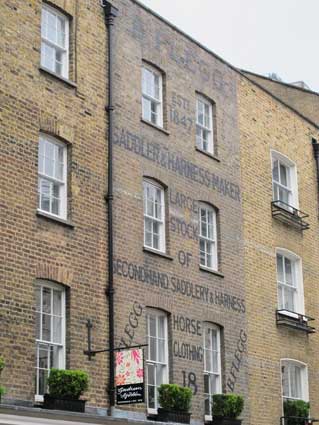
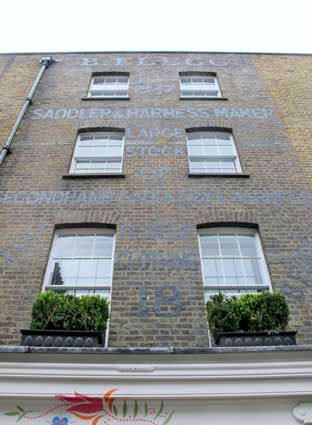
'B. FLEGG
EST.
1847
SADDLER & HARNESS MAKER
LARGE
STOCK
OF
SECONDHAND SADDLERY & HARNESS
HORSE
CLOTHING
18'
WITH 'B. FLEGG'
angled at each side. A prime example of 'using every part of a building
to advertise your business'. In 2012 these premises – or the shop
below them – were run by a fabric designer, by the look of it.
The sign has been restored
and is at 18 Monmouth Street; echoes of another time when humanity
relied on the horse for so many things. 'Horse Clothing' presumably
refers to clothing worn by a person while riding a horse.
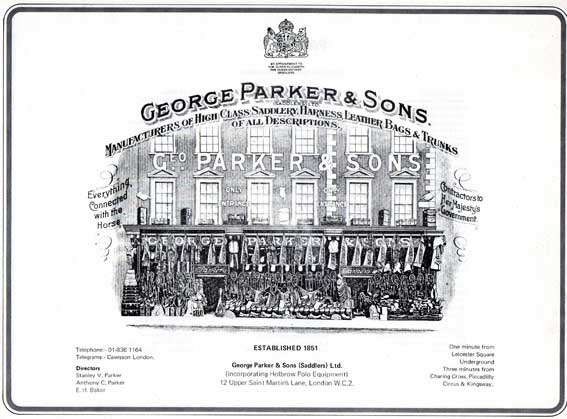
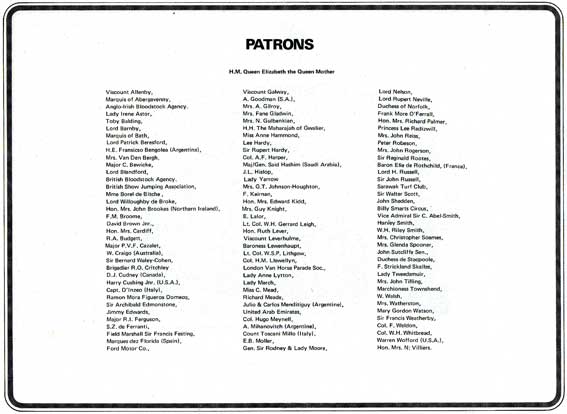
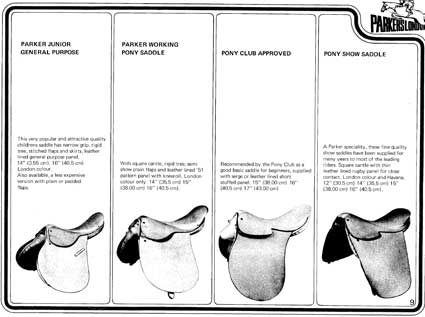 Images
courtesy Susan H
Images
courtesy Susan H
26-28 Long Acre
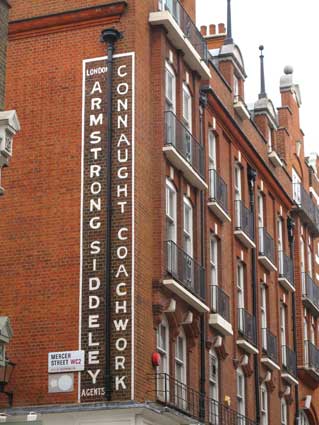
'LONDON
ARMSTRONG SIDDELEY
AGENTS
CONNAUGHT COACHWORK'
This long
vertical sign with its tiny words 'London ...
Agents' in the first column is in fine fettle at Long Acre, on the
corner with Mercer Street. The street was completed in the early 17th
century. It was once known for its coach-makers, and later for its car
dealers.
Rose Street
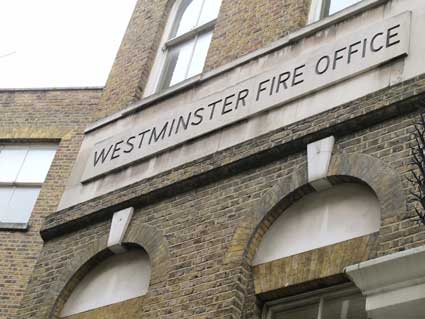
'WESTMINSTER
FIRE OFFICE'
Rose Street, Covent Garden, a lane which runs from Long
Acre across Floral
Street to Garrick Street. In Rose Street, just in front and to the
right of the Lamb and Flag public house is the Westminster Fire Office,
one of the original fire insurance companies who also ran a private
fire-fighting service.
Mays Court
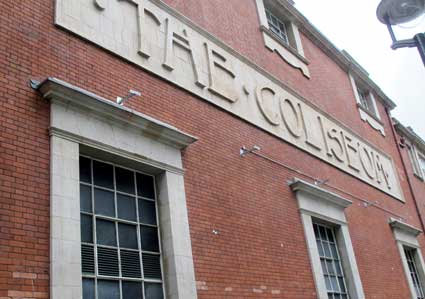
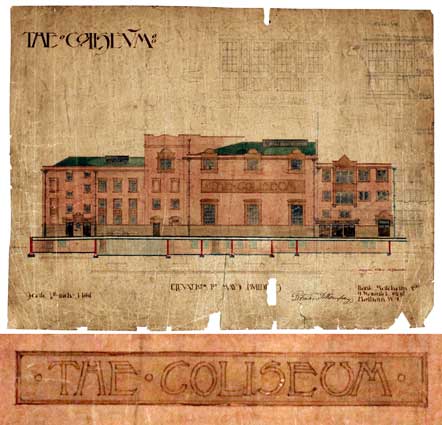
This very
large, Art Nouveau-inspired relief lettering
is in Mays Court, running between St Martin's Lane and Bedforbury:
'THE
COLISEUM'
The London
Coliseum was designed by Frank Matcham for
Sir Oswald Stoll with the ambition of being the largest and finest
‘People’s palace of entertainment’ of the
age. The
theatre’s original slogan was PRO BONO PUBLICO (For the
public
good). It was opened in 1904 and the inaugural performance was a
variety bill on 24 December that year. With 2,359 seats it is the
largest theatre in London. It underwent extensive renovations between
2000 and 2004 when an original staircase planned by Frank Matcham was
finally put in to his specifications.The theatre changed its name from
the London Coliseum to the Coliseum Theatre between 1931 and 1968.
During the Seond World War, the Coliseum served as a canteen for Air
Raid Patrol workers, and Winston Churchall gave a speech from the
stage. After 1945 it was mainly used for American musicals before
becoming in 1961 a cinerama or seven years. In 1968 it
reopened
as The London Coliseum, home of Sadler’s Wells Opera. In 1974
Sadler’s Wells became ENO and the Company bought the freehold
of
the building for £12.8 million in 1992. The London Coliseum
has
the widest proscenium arch in London (55 feet wide and 34 feet high
– the stage is 80 feet wide, with a throw of over 115 feet
from
the stage to the back of the balcony) and was one of the first theatres
to have electric lighting. It was built with a revolving stage although
this was rarely used which consisted of three concetnric rings and was
75 feet cross in total and cost Stoll £70,000. A range of
modern
features included electric lifts for patrons, a roof garden and an
Information Bureau in which physicians or others expecting urgent
telephone calls or telegrams could leave their seat numbers and be
immediately informed if required.
See also the Victoria Palace (below) for lettering on a Matcham London
theatre.
In 1994 ENO acquired some 200 architectural drawings from the firm of
Frank Matcham. This shows the elevation in May's Court and the panel
containing the theatre name is clearly shown with the lettering
accurately drawn by Matcham, as it can be seen today. May's Court was
one of those lanes in the West End which was too small for modern
vehicles, so became a pedestrian area with a long double line of K7 red
telephone boxes, now gone.
Victoria Station and Victoria
Palace
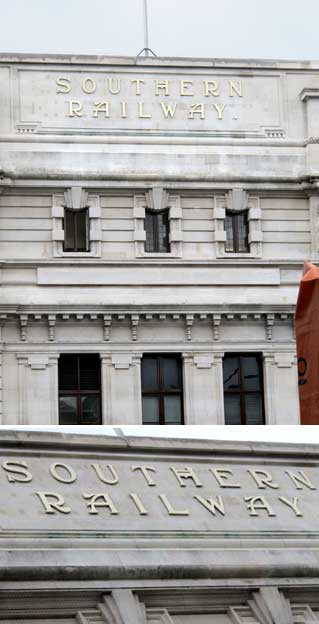
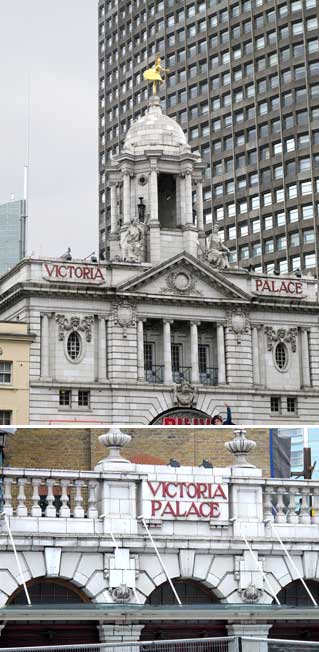
'SOUHERN
RAILWAY.'
Decorative
relief capitals picked out in gold on a
building adjoining the main Victoria Station. Also, opposite the
station:
'VICTORIA
PALACE'
The theatre
began life as a small concert room above
the stables of the Royal Standard Hotel, a small hotel and tavern built
in 1832 at what was then 522 Stockbridge Terrace, on the site of the
present theatre. The proprietor, John Moy, enlarged the building, and
by 1850 it became known as Moy's Music Hall. Alfred Brown took it over
in 1863, refurbished it, and renamed it the Royal Standard Music Hall.
The hotel was demolished in 1886, by which time the main line terminus,
Victoria Station and its new Grosvenor Hotel, had transformed the area
into a major transport hub. The railways were at this time building
grand hotel structures at their termini, and Victoria was one of the
first. Added to this was the integration of the electric underground
system and the building of Victoria Street. The owner of the music
hall, Thomas Dickey, had it rebuilt along more ambitious lines in 1886
by Richard Wake, retaining the name Royal Standard Music Hall. The
Royal Standard, was demolished in 1910, and in its place was built, at
a cost of ₤12,000, the current theatre, The Victoria Palace. It was
designed by prolific theatre architect Frank Matcham, and opened
November 6, 1911.
See also The Coliseum (above) for lettering on a Matcham London theatre.
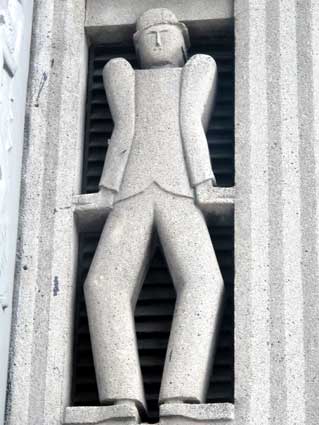
As far as we can remember, this little fellow is the
end of a ventilation duct on the Victoria Palace theatre.
61-62 St Giles High Street (end
wall overlooking St Giles churchyard)
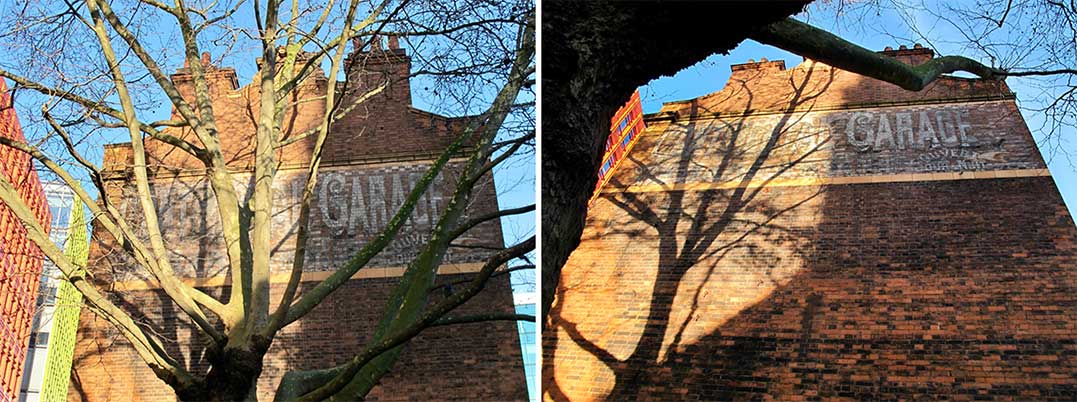 2016 image
2016 image
This painted sign is high up on the end wall of The Angel public house;
it is obscured by a big tree in St. Giles in the Fields churchyard:
'CONTINENTAL GARAGE
OPEN DAY & NIGHT CARS ON
HIRE OUVERT JOUR & NUIT'
This area of London in
the early 20th century had a sizeable French community which presumably
were wealthy enough to rent cars. Hence the use of some French words.
This decorative lettering must have been over-painted and the successor
business: 'PRINCE'S GARAGE' added in dark capitals. Oddly, the latter
has nearly been washed away by the rain and the original name is now
dominant. Sébastien Ardouin on the Painted signs and mosaics website
(see Links) has spotted, in the upper left
corner, what must be the name of the sign writer: 'R.
SANDLAND OPPOSITE'.
Coincidentally, the
lower right corner of the sign features a rather finely-rendered
manicule (cuffed pointing hand), as does the name panel on the facade
of The Angel (see below).
 Two
manicules for the price of one
Two
manicules for the price of one
For further examples see our London Galleries page.
 Two
manicules for the price of one
Two
manicules for the price of one All
photographs courtesy David Gaylard
All
photographs courtesy David Gaylard
 All images
2012
All images
2012



 Images
courtesy Susan H
Images
courtesy Susan H






